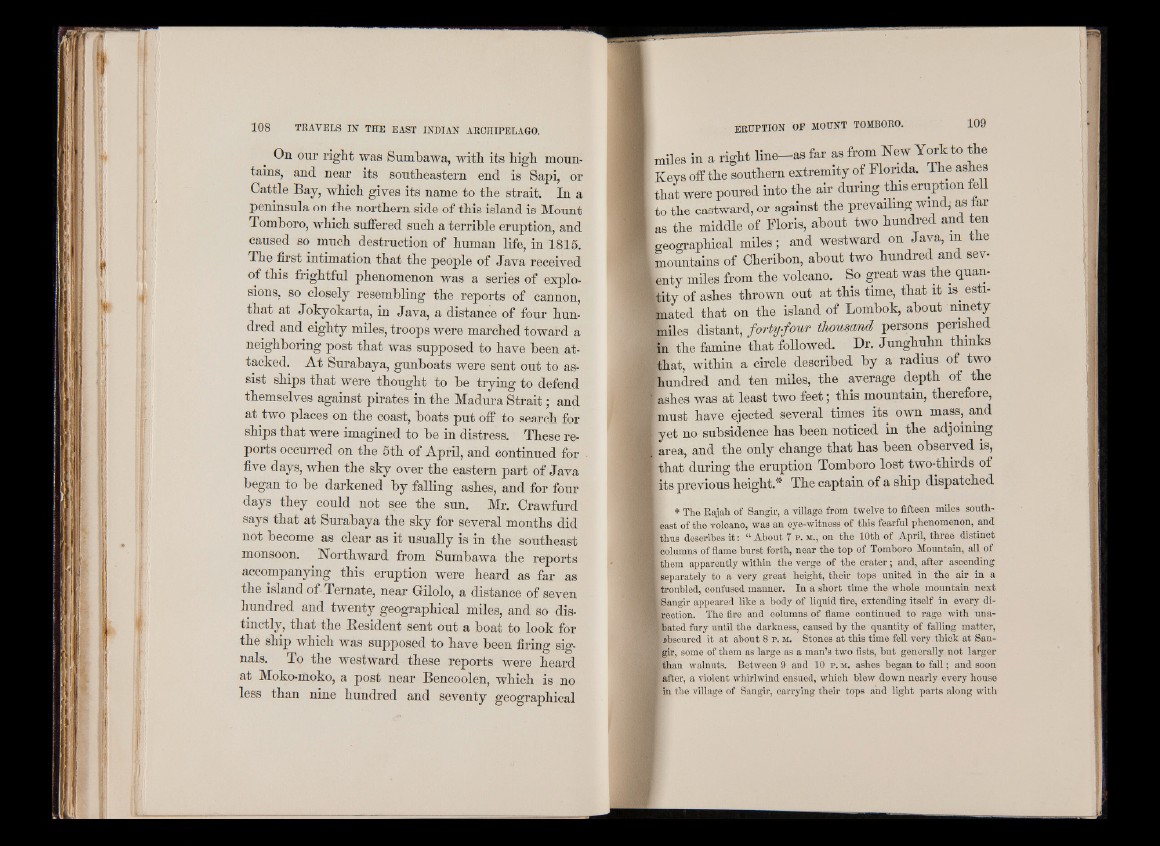
On our right was Sumbawa, with its high mountains,
and near its southeastern end is Sapi, or
Cattle Bay, which gives its name to the strait. In a
peninsula on the northern side of this island is Mount
Tomboro, which suffered such a terrible eruption, and
caused so much destruction of human life, in 1815.
The first intimation that the people of Java received
of this frightful phenomenon was a series of explosions,
so closely resembling the reports of cannon,
that at Jokyokarta, in Java, a distance of four hundred
and eighty miles, troops were marched toward a
neighboring post that was supposed to have been attached.
A t Surabaya, gunboats were sent out to assist
ships that were thought to be t r y i n g to defend
themselves against pirates in the Madura S tra it; and
at two places on the coast, boats put off to search for
ships that were imagined to be in distress. These reports
occurred on the 5th of April, and continued for
five days, when the shy over the eastern part of Java
began to be darhened by falling ashes, and for four
days they could not see the sun. Mr. Crawfurd
says that at Surabaya the shy for several months did
not become as clear as it usually is in the southeast
monsoon. Northward from Sumbawa the reports
accompanying this eruption were heard as far as
the island of Ternate, near Gilolo, a distance of seven
hundred and twenty geographical miles, and so distinctly,
that the Resident sent out a boat to looh for
the ship which was supposed to have been firing signals.
To the westward these reports were heard
at Moho-moho, a post near Bencoolen, which is no
less than nine hundred and seventy geographical
L iles in a right lin e -a s far as from New York to the
Keys off the southern extremity of Florida. The ashes
that were poured into the air during this eruption fell
I to the eastward, or against the prevailing wmd, as far
las the middle of Floris, about two hundred and ten
[ geographical miles; and westward on Java, m the
t mountains of Cheribon, about two hundred and sev-
lenty miles from the volcano. So great was the quan-
Itity of ashes thrown out at this time, that it is esti-
Imated that on the island of Lombok, about ninety-
miles distant, forty-four thousand persons penshed
in the famine that followed. Dr. Junghuhn thinks
jlfhat, within a circle described by a radius of two
i hundred and ten miles, the average depth of the
lashes was at least two feet; this mountain, therefore,
¡must have ejected several times its own mass, and I yet no subsidence has been noticed in the adjoining
I area, and the only change that has been observed is,
I that during the eruption Tomboro lost two-thirds of
I its previous height.* The captain of a ship dispatched
* The Rajah of Sangir, a village from twelve to fifteen miles south-
■east of the volcano, was an eye-witness of this fearful phenomenon, and
■thus describes it: “ About 7 p. m., on the 10th of April, three distinct
■columns of flame hurst forth, near the top of Tomboro Mountain, all of
■them apparently within the verge of the crater; and, after ascending
■separately to a very great height, their tops united in the air in a
■troubled, confused manner. In a short time the whole mountain next
■Sangir appeared like a body of liquid fire, extending itself in every di-
■rection. The fire and columns of flame continued to rage with una-
| hated fury until the darkness, caused by the quantity of falling matter,
■ibscured it at about 8 p. m. Stones at this time fell very thick at San-
■ gir, some of them as large as a man’s two fists, hut generally not larger
■ th a n walnuts. Between 9 aDd 10 p. m. ashes began to fall; and soon
Rafter, a violent whirlwind ensued, which blew down nearly every house
■ in the village of Sangir, carrying their tops and light parts along with